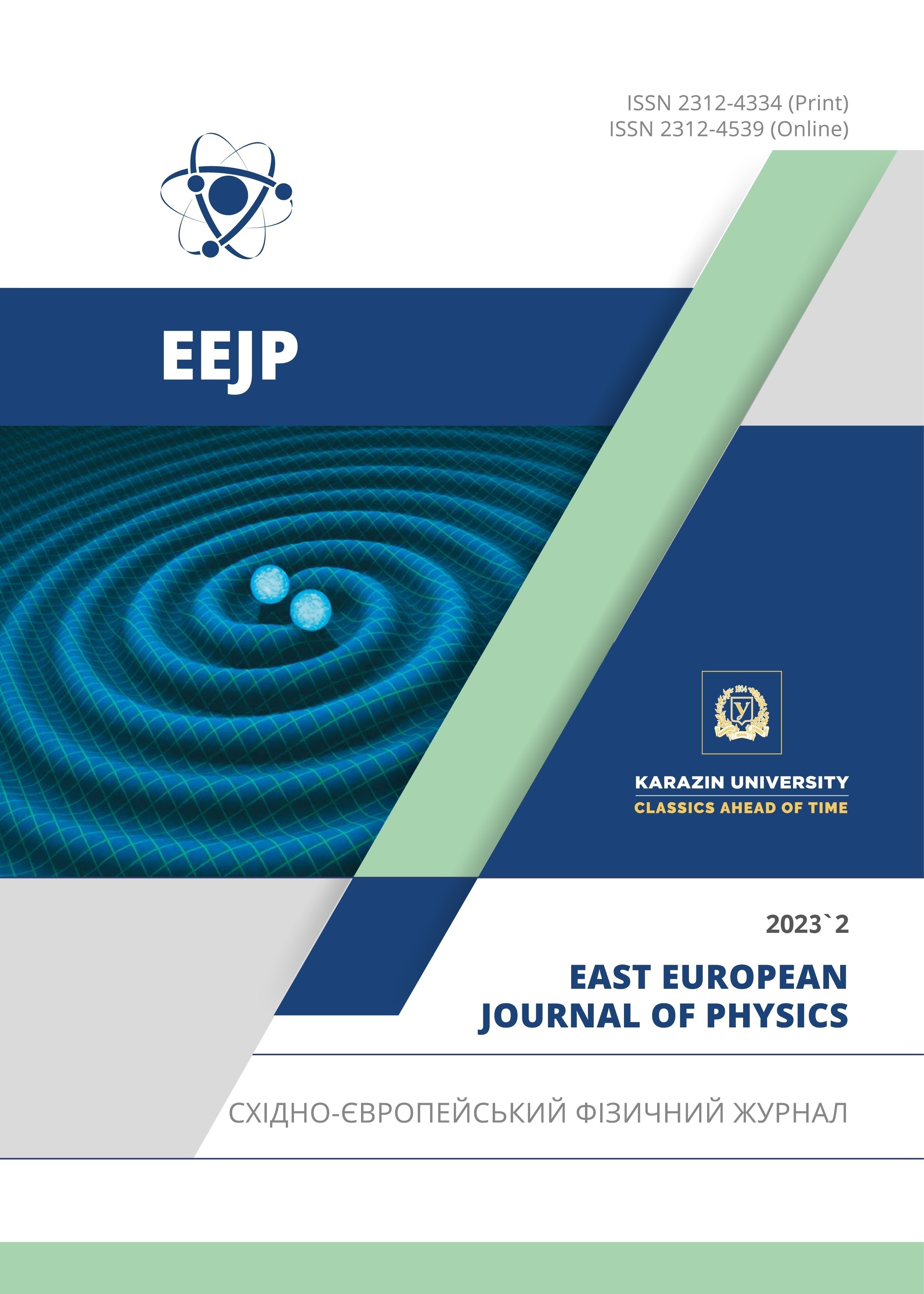Composite Fermions QED Lagrangian Density in Fractional Formulation
Abstract
Quantum electrodynamics (QED) is a highly precise and successful theory that describes the interaction between electrically charged particles and electromagnetic radiation. It is an integral part of the Standard Model of particle physics and provides a theoretical basis for explaining a wide range of physical phenomena, including the behavior of atoms, molecules, and materials. In this work, the Lagrangian density of Composite Fermions in QED has been expressed in a fractional form using the Riemann‑Liouville fractional derivative. The fractional Euler-Lagrange and fractional Hamiltonian equations, derived from the fractional form of the Lagrangian density, were also obtained. When α is set to 1, the conventional mathematical equations are restored.
Downloads
References
Y.L. Wang, and C.T. Xu, “Dirac Canonical Quantization of Composite Fermions QED”, International Journal of Theoretical Physics, 49, 421 (2010). https://doi.org/10.1007/s10773-009-0211-y
Z. Li, “Quantum field theory for a system of interacting photons, electrons, and phonons”, International Journal of Theoretical Physics, 35(7), 1353 (1996). https://doi:10.1007/bf02084945
M. Kossow, “Quantum field theory and composite fermions in the fractional quantum Hall effect”, Annalen Der Physik, 18(5), 285(2009). https://doi.org/10.1002/andp.200910350
R.R. Du, A.S. Yeh, H.L. Stormer, D.C. Tsui, L.N. Pfeiffer, and K.W. West, “Fractional Quantum Hall Effect around v=3/2 : Composite Fermions with a Spin”, Physical Review Letters, 75(21), 3926 (1995). https://doi.org/10.1103/physrevlett.75.3926
J.K. Jain, “Composite-fermion approach for the fractional quantum Hall effect”, Physical Review Letters, 63(2), 199(1989). https://doi.org/10.1103/physrevlett.63.199
A. Lopez, and E. Fradkin, “Universal structure of the edge states of the fractional quantum Hall states”, Physical Review B, 59(23), 15323 (1999). https://doi.org/10.1103/physrevb.59.15323
V. Kalmeyer, and S.C. Zhang, “Metallic phase of the quantum Hall system at even-denominator filling fractions”, Physical Review B, 46(15), 9889 (1992). https://doi.org/10.1103/physrevb.46.9889
D. Baleanu, and S. I. Muslih, “Fractional Euler-Lagrange and Fractional Hamilton Equations for super Symmetric Classical”, Fractals, 15(04), 379 (2007). https://doi.org/10.1142/s0218348x07003642
D. Baleanu, and O.P. Agrawal, “Fractional Hamilton Formalism Within Caputo’s Derivative”, Czechoslovak Journal of Physics 56, 1087 (2006). https://doi.org/10.1007/s10582-006-0406-x
R. Hilfer, Applications of Fractional Calculus in Physics, (World Scientific Publishing Company, Singapore, New Jersey, London and Hong Kong, 2000). https://doi.org/10.1142/3779
M.A.E. Herzallah, and D. Baleanu, “Fractional-order Euler–Lagrange equations and formulation of Hamiltonian equations”, Nonlinear Dynamics, 58, 385 (2009). https://doi.org/10.1007/s11071-009-9486-z
A.A. Diab, R.S. Hijjawi, J.H. Asad, and J.M. Khalifeh, “Hamiltonian formulation of classical fields with fractional derivatives: revisited”, Meccanica, 48, 323–330 (2013). https://doi.org/10.1007/s11012-012-9603-9
A.D. Al-Oqali, “Fractional formulation of Podolsky Lagrangian density”, International Journal of Advanced and Applied Sciences, 9(2) 136 (2022). https://doi.org/10.21833/ijaas.2022.02.015
A.D. Al-Oqali, B.M. Al-Khamiseh, E.K. Jaradat, and R.S. Hijjawi, “The Linear Sigma Model Lagrangian Density: Fractional Formulation”, Canadian Journal of Pure and Applied Sciences, 10, 3803 (2016).
R.E. Gutiérrez, J.M. Rosário, and J.T. Machado, “Fractional Order Calculus: Basic Concepts and Engineering Applications”, Mathematical Problems in Engineering, 2010, 1 (2010). https://doi.org/10.1155/2010/375858
F. Riewe, “Nonconservative Lagrangian and Hamiltonian mechanics”, Physical Review E, 53(2), 1890 (1996). https://doi.org/10.1103/physreve.53.1890
E.K. Jaradat, R.S. Hijjawi, and J.M. Khalifeh, “Maxwell’s equations and electromagnetic Lagrangian density in fractional form”, Journal of Mathematical Physics, 53(3), 033505 (2012). https://doi.org/10.1063/1.3670375
V.E. Tarasov, “Fractional vector calculus and fractional Maxwell’s equations”, Annals of Physics, 323(11), 2756 (2008). https://doi.org/10.1016/j.aop.2008.04.005
T.P. Stefański, and J. Gulgowski, “Fundamental properties of solutions to fractional-order Maxwell's equations”, Journal of Electromagnetic Waves and Applications, 34(15), 1955 (2020). https://doi.org/10.1080/09205071.2020.1801520
S.I. Muslih, O.P. Agrawal, and D. Baleanu, “A Fractional Schrödinger Equation and Its Solution”, International Journal of Theoretical Physics, 49(8), 1746 (2010). https://doi.org/10.1007/s10773-010-0354-x
N. Laskin, “Fractional Schrödinger equation”, Physical Review E, 66(5), (2002). https://doi.org/10.1103/physreve.66.056108
S.I. Muslih, O.P. Agrawal, and D. Baleanu, “A fractional Dirac equation and its solution”, Journal of Physics A: Mathematical and Theoretical, 43(5), 055203 (2010). https://doi.org/10.1088/1751-8113/43/5/055203
O.P. Agrawal, “Formulation of Euler–Lagrange equations for fractional variational problems”, Journal of Mathematical Analysis and Applications, 272(1), 368 (2002). https://doi.org/10.1016/s0022-247x(02)00180-4
Copyright (c) 2023 Amer D. Al-Oqali

This work is licensed under a Creative Commons Attribution 4.0 International License.
Authors who publish with this journal agree to the following terms:
- Authors retain copyright and grant the journal right of first publication with the work simultaneously licensed under a Creative Commons Attribution License that allows others to share the work with an acknowledgment of the work's authorship and initial publication in this journal.
- Authors are able to enter into separate, additional contractual arrangements for the non-exclusive distribution of the journal's published version of the work (e.g., post it to an institutional repository or publish it in a book), with an acknowledgment of its initial publication in this journal.
- Authors are permitted and encouraged to post their work online (e.g., in institutional repositories or on their website) prior to and during the submission process, as it can lead to productive exchanges, as well as earlier and greater citation of published work (See The Effect of Open Access).








